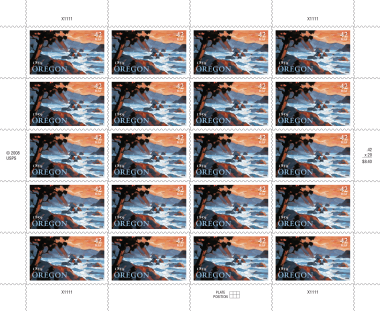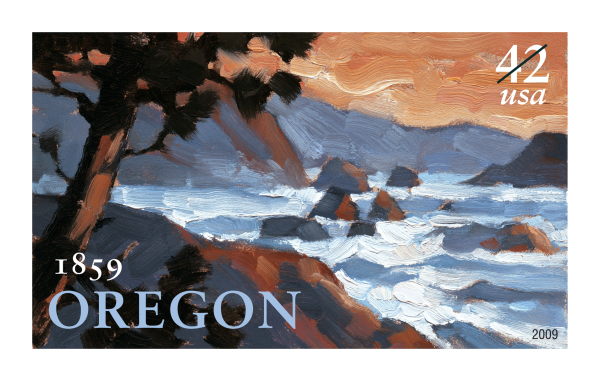
About This Stamp
With the issuance of this stamp in 2009, the U.S. Postal Service commemorates the sesquicentennial of Oregon's statehood. Oregon was officially welcomed as the 33rd state in the Union on February 14, 1859. Today, Oregon boasts a diverse population, an active and innovative urban scene, and some of the most beautiful and fertile landscapes in the country.
Within a few decades of the Lewis and Clark expedition into Columbia River country, overland immigrants from the east began to pour into the "New Eden." By the mid-1800s, thousands had followed the Oregon Trail with dreams of owning land and starting a new life. The Oregon Donation Land Act of 1850 granted as much as 320 acres of land to male settlers, plus an additional 320 acres to their wives, which spurred some hasty marriages. Of course, American settlers weren't the only inhabitants. Native Americans had been living in the area for countless generations, and Spanish and British groups were making their claims as well.
For almost 30 years, the U.S. and Britain agreed on joint occupation of the territory, but tension was brewing over borders and natural resources. In 1846, the countries agreed on a boundary at the 49th parallel (now part of the U.S.–Canadian border). The new Oregon Territory included present-day Oregon, Washington, Idaho, and western Montana and Wyoming. The land was split into the Oregon and Washington Territories in 1853. The Oregonians formed a provisional government and agreed on a state constitution. On February 14, 1859, President James Buchanan signed the legislation granting statehood to Oregon.
From the rocky Pacific coast to the snowcapped Cascade Mountains and high eastern desert, Oregon's landscapes are picturesque and attract visitors throughout the seasons. Crater Lake, with a depth of nearly 2,000 feet, is the deepest lake in the country, and Mt. Hood towers over the state with an elevation of 11,239 feet. Many of the 3.7 million residents live in Portland and the Willamette Valley. Oregonians enjoy a healthy lifestyle and appreciate the wilderness and their state's rich cultural heritage. For decades, Oregon's economy was mainly dependent on natural resources like timber and cash crops, though the technology industry became a top employer in the 1990s.
Scientist Linus Pauling, winner of the Nobel Prize in Chemistry in 1954 and the Nobel Peace Prize in 1962, was born and raised in Oregon. Beverly Cleary, author of numerous popular children's novels, spent her childhood in Portland. Other notable Oregonians include Phil Knight, creator of Nike, Inc., and James Beard, a chef who revolutionized American cooking.
Stamp Art Director

Derry Noyes
For more than 40 years Derry Noyes has designed and provided art direction for close to 800 United States postage stamps and stamp products. She holds a bachelor of arts degree from Hampshire College and a master of fine arts degree from Yale University.
Noyes worked as a graphics designer at Beveridge and Associates, a Washington, D.C., firm, until 1979 when she established her own design firm, Derry Noyes Graphics. Her clients have included museums, corporations, foundations, and architectural and educational institutions. Her work has been honored by American Illustration, the Art Directors Club of Metropolitan Washington, Communication Arts, Critique magazine, Graphis, Creativity International, and the Society of Illustrators.
Before becoming an art director for the U.S. Postal Service, she served as a member of the Citizens' Stamp Advisory Committee from 1981 to 1983.
Noyes is a resident of Washington, D.C.
Stamp Artist

Gregory Manchess
Painter Gregory Manchess has worked as a freelance illustrator for more than 40 years on advertising campaigns, magazines, and book covers. His work has appeared on covers and in feature stories for National Geographic magazine, TIME magazine, The Atlantic Monthly, and Smithsonian Magazine.
Noting his passion for history, the National Geographic Society sent Manchess on an expedition to record the exploits of explorer David Thomson. The Society also chose his work to illustrate the traveling exhibition, Real Pirates: The Untold Story of The Whydah, from Slave Ship to Pirate Ship. His large portrait of Abraham Lincoln and seven other paintings of moments from Lincoln’s life are exhibited at the Abraham Lincoln Memorial Library and Museum in Springfield, Illinois.
The artist has illustrated children’s books, including Nanuk: Lord of the Ice and Cheyenne Medicine Hat, written by Brian Heinz, and To Capture the Wind by author Sheila MacGill-Callahan.
Manchess is included in Walt Reed’s edition of The Illustrator in America, 1860–2000. Widely awarded within the industry, he exhibits frequently at the Society of Illustrators in New York. The Society presented him with its highest honor, the coveted Hamilton King Award.
Today, Manchess divides his time between New York and Kentucky, his native state. He lectures frequently at universities and colleges nationwide, gives painting workshops at the Norman Rockwell Museum in Stockbridge, MA, and teaches at the Illustration Master Class in Amherst, MA.
His figure and portrait work has led to numerous commissions for stamps by the U.S. Postal Service, including Oregon Statehood (2009); Mark Twain (2011); The 1963 March On Washington (2013); five paintings for Enjoy the Great Outdoors (2020); 10 for Snowy Beauty (2022); four for Snow Globes (2023); and four for A Day at the Beach (2026).
